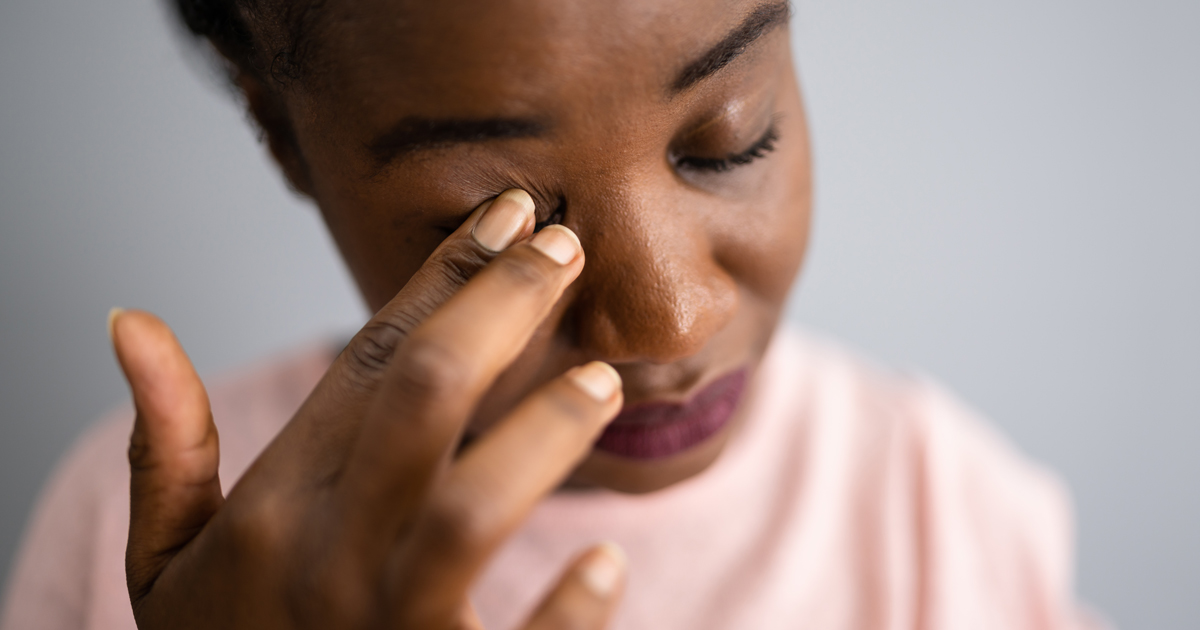Pink eye: What it is and how to treat it

Conjunctivitis, also commonly known as pink eye, is a condition that can be caused by an infection or a reaction to allergens. The term pink eye comes from the fact that it typically causes redness or swelling of the white of the eye.
"You can develop pink eye by coming in contact with the virus or bacteria organism on a surface and then touching your face or eyes," says Desinee Drakulich, OD, Nebraska Medicine optometrist. "People who wear contact lenses are also more susceptible to pink eye if they don't wash their hands well when changing out their contact lenses or if they wear them beyond their recommended use."
Viral conjunctivitis
Pink eye caused by viruses are the most common and are highly contagious. These infections usually clear up on their own after about seven to 14 days.
Symptoms of viral conjunctivitis
- Redness in the white of the eyes
- Prominent blood vessels
- Pain or burning sensation
- Watery eyes
- Fever
Because most cases of viral conjunctivitis are mild, treatments are rarely recommended unless you have a very severe form. Over-the-counter drops like artificial tears can be used to help soothe your eyes.
Because the virus is very contagious, you should be careful not to touch your face or eyes when you are around others to avoid spreading the virus.
Treatment for viral conjunctivitis
- Over-the-counter artificial tears
- Frequent hand washing
- Change pillow cases and sheets frequently
- Avoid sharing towels
- Avoid close contact with others, such as touching or shaking hands
Bacterial conjunctivitis
Conjunctivitis caused by a bacterial infection is most common among young children. "Adults rarely get this form of pink eye. Typically, they come in contact with this type of bacteria fairly frequently over the years and have become immune to it," says Dr. Drakulich.
While not as contagious as viral conjunctivitis, it can spread quickly in a daycare or school environment as children tend to touch everything around them as well as their face and eyes, notes Dr. Drakulich.
Symptoms of bacterial conjunctivitis differ slightly from a viral infection. The telltale sign of a bacterial infection is a green and yellow discharge. It will also cause itching and is usually not painful.
Symptoms of bacterial conjunctivitis
- Red, swollen eyes
- Itchy, watery eyes
- Green and yellow discharge from the eyes
- Fever
Bacterial conjunctivitis is treated with a topical antibiotic. "While it may get better without treatment, an antibiotic will shorten the length of infection, prevent complications and decrease spread to others," says Dr. Drakulich. "I strongly recommend getting your child diagnosed and treated. If left untreated, the infection could become more serious. This may require hospitalization and cause permanent vision damage. If your child develops a fever, this is often a sign of a more serious infection and needs medical evaluation."
Dr. Drakulich recommends keeping your child home for the first 24 to 48 hours after starting an antibiotic to reduce spread.
Treatment for bacterial conjunctivitis
- Topical antibiotic
- Frequent hand washing
- Wash pillows cases, sheets and bedding frequently
- Avoid sharing towels
Allergic conjunctivitis
Allergic conjunctivitis is not contagious and occurs more often in people with allergic conditions, asthma or eczema. Antibiotics will not make the condition better but antihistamines and artificial tears can help symptoms by soothing the eyes and reducing itching.
Treatment for allergic conjunctivitis
- Allergy medications
- Over-the-counter allergy eye drops
Other causes of conjunctivitis include:
Fungal conjunctivitis
Fungal conjunctivitis is usually associated with getting organic material in your eye, like a tree branch, and becoming injured. This type of infection can be very difficult to treat and should be evaluated by your doctor immediately.
Symptoms of fungal conjunctivitis
- Red, painful eye
- Inflammation of the eye
What if my pink eye keeps returning?
If your pink eye returns after treatment, this is probably a sign that it was not appropriately treated and needed further evaluation, advises Dr. Drakulich. It may also return repeatedly due to allergies or dry eyes. Dry eye is a condition caused when your eyes cannot provide adequate lubrication. It can cause your eyes to become red, inflamed and may cause stinging or burning.
When to see a doctor for pink eye
- Your child has normal symptoms of conjunctivitis, in addition to a fever
- Vision problems
- Extreme eye pain
- Suppressed immune system or other chronic medical problems
- Bacterial infection that doesn't clear up after five days
Pink eye can become serious if not treated properly. Not sure what is causing your pink eye, or if it's not clearing up? Call 800.922.0000 to schedule an appointment with an eye specialist.






